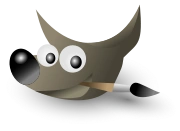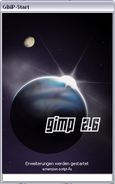The GNU Image Manipulation Program, or GIMP, is a raster graphics editor used to process digital graphics and photographs. Typical uses include creating graphics and logos, resizing and cropping photos, altering colours, combining multiple images, removing unwanted image features, and converting between different image formats. GIMP can also be used to create basic animated images in GIF format. It is often used as a free software replacement for Adobe Photoshop, the most widely used bitmap editor in the printing and graphics industries; however, it is not designed to be a Photoshop clone. The project's mascot is named Wilber.

The GIMP mascot, Wilber.
The project was started in 1995 by Spencer Kimball and Peter Mattis and is now maintained by a group of volunteers under the auspices of the GNU Project. The latest version of GIMP, v. 2.4.6, was released on May 30, 2008. Available under the terms of the GNU General Public License, GIMP is free software, however this (as with all software licensed under GPL) is a reference to your ability to modify the source-code, rather than be able to use it gratis.
Features[]
Brushes dialog in GNOMEGIMP's manipulation tools can be accessed via the toolbox, menu paths, and dialog boxes (which can be grouped in docks). They include filters and brushes, as well as transformation, selection, layer and masking tools.
For example, GIMP comes with 48 standard brushes, plus facilities to create new ones. Brushes (and brush tools) can be used in hard-edged, soft-edged, or eraser modes, be applied at different opacities, or used with different modes for composition.
Color support[]
GIMP also has a palette with RGB, HSV, color wheel, CMYK, and mixing modes, plus tools to pick colors from the image with various averaging options. There is support for hexadecimal color codes (as used in HTML). "CMYK" colors are immediately translated into RGB when used; GIMP does not have any built-in support for CMYK mixtures that cannot be represented in RGB, such as rich blacks, though they can be simulated to a limited extent with third-party add-ons.
GIMP supports gradients, which integrate into its other tools (such as brushes and fills) to shade image areas with automated color blending. It includes a variety of built-in gradients, and as with the brushes, also allows the user to customize and create their own gradient fills.
Selection and masking tools[]
Animation showing three docked and tabbed dialogs: layers, channels, and paths.GIMP can perform rectangular or circular selection, freehand selection, and "by color" selection. Alternatively, the Smart Selection tool, known as the "Magic Wand", can be used to select contiguous regions. The Intelligent Scissors (iScissors) tool can be used to auto-create paths between regions defined by strong color-changes. the 'Foreground select' tool is available since 2.4 uses vision science to select an object in the foreground with some few mouse strokes by the user.
GIMP has support for layers, including transparent layers, which can be shown, hidden, or made semitransparent. It also supports transparent and semitransparent images. Channels add different types of opacity and color effects to images.
Paths[]
Paths containing line segments or Bezier curves can be created using the Path tool. Paths can be named, saved, and painted (or "stroked") with brushes, patterns, or various line styles. Paths can also be used to create complex selections.
Effects, scripts, and filters[]
GIMP has approximately 150 standard effects and filters, including Drop Shadow, Blur, Motion blur and Noise.
GIMP operations can be automated with scripting languages. A Scheme interpreter named Script-Fu is built in (but switched to TinyScheme as of GIMP 2.4.), and external Perl, Python, or Tcl can be used. Ruby support is in experimental development. These scripts and plugins for GIMP can be used interactively, or combined non-interactively.
Gallery[]
External links[]
| https://upload.wikimedia.org/wikipedia/commons/9/98/Wikipedia_small_logo_rounded.png | This page uses Creative Commons Licensed content from Wikipedia (view authors). |

